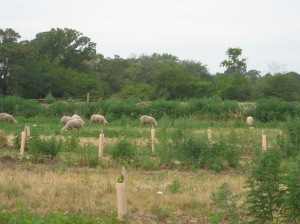I can’t believe it’s November already. The crisp autumn air has me salivating in anticipation of the food I will enjoy in the coming months. I am looking forward to celebrating my own Thanksgiving tradition, where I pack my two bedroom apartment with 20 guests and serve them home cooked meal with the help of my wonderful co-host, Stephanie Calloway. (Check out her blog about her amazing rooftop garden)
This will be our third Thanksgiving we host together and the meal has become a bit more extravagant each year. This year’s menu includes a lot of food from local farmers, including the subject of this week’s blog post- Hazel Valley Farm. Lucky for me, I saved a pound of their hazelnuts in my freezer to use in this year’s Thanksgiving stuffing.
Jeannie Herold is the owner and operator of Hazel Valley Farm. She is clearly the heart and soul of the farm. “She’s the farmer and I’m the farmer’s husband,” Dean, Jeanne’s husband explained.
When I arrived at Hazel Valley Farm, I was lucky enough to meet with both Jeannie and Dean as they were processing chickens. Dean was outside slaughtering the birds and removing the feathers with what I can best describe as a “chicken tumbler.” Folks, if you have ever had to pluck your own birds, I recommend you find someone who has one of these contraptions.
Basically, after the bird is slaughtered, it is put into a hot pot of water to loosen the feathers. When you remove the bird from the water, you place it in the rotating tumbler and spray the feathers off. Simple and easy way to remove the feathers and a heck of a better way then hand plucking them!
Jeannie took a break from processing to show me around the rest of the farm. I had to ask, “Why hazelnuts?”
Jeannie explained that hazelnuts are native to Wisconsin, and in 2003 they planted 15,000 hazelnut bushes on their property in Eagle, WI. Since hazelnuts are native to the area, they are usually able to handle Wisconsin’s climate, however, with the extreme heat this summer, Jeannie had to scramble to ensure the bushes had adequate water. However, keeping the hazelnut field free from extraneous vegetation hasn’t been much of a problem:
Jeannie allows the lambs to graze and eat throughout the day in the hazel field. The lambs generally will not disturb the hazelnut bushes since they prefer other native plants found in the field. At dusk, Jeannie herds the lambs back into a closed pen and releases her two dogs to patrol the field. “I tried everything to keep the deer from eating the hazelnut bushes, but the only thing that has worked so far is my two dogs. When a deer jumps into the field, one dog tries to play with it and the other tries to herd it. The [frustrated and confused] deer eventually gives up and leaves.”
Our final stop was to see the pigs. This place was pig paradise. Jeannie’s pigs are provided with plenty of open space, shade, mud, and all the hazelnuts they can eat.
That’s right, Jeannie feeds her pigs hazelnuts. I was fortunate enough to see this group of pigs eat, excuse me, devour their first hazelnuts. The hazelnuts are not shelled when fed to the pigs, in fact, when they eat them they are able to crack and shell them with their teeth. The shell just falls from the side of their mouth so they can keep gobbling up. What does a herd of pigs eating hazelnuts sound like, you ask? Like a group of people popping bubble wrap all at once.
Hazel Valley Farm is truly a unique farm and Jeannie does a tremendous job of keeping her plants and animals healthy and happy. If you are interested in purchasing hazelnuts for your Thanksgiving dinner, or any other products, please visit the Hazel Valley Farm website. I want to thank Jeannie and Dean for showing me around their farm and I will definitely be purchasing from them in the near future!










